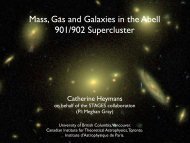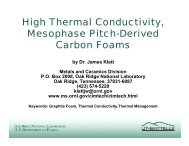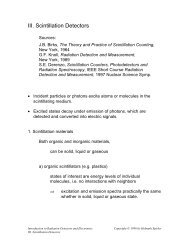Introduction to radiation-resistant semiconductor devices and circuits
Introduction to radiation-resistant semiconductor devices and circuits
Introduction to radiation-resistant semiconductor devices and circuits
Create successful ePaper yourself
Turn your PDF publications into a flip-book with our unique Google optimized e-Paper software.
Type NMOS PMOS NMOS PMOS NMOS PMOS NMOS PMOS<br />
Width 75 75 1332 1332 888 888 1332 1332<br />
Length 1.2 1.2 1.2 1.2 2.2 2.2 3.2 3.2<br />
Id /W= 0.03<br />
0 Mrad 0.81 0.61 0.64 0.59 0.66 0.50<br />
5 Mrad 2.17 0.84 1.00 0.58 1.50 0.69<br />
Id /W= 0.1<br />
0 Mrad 1.10 0.70 1.20 1.10 0.80 0.80 0.80 0.60<br />
5 Mrad 3.80 1.10 3.40 1.60 1.30 0.90 1.70 0.70<br />
Id /W= 0.3<br />
0 Mrad 1.60 1.30 2.00 1.70 1.10 1.00 1.10 0.77<br />
5 Mrad 5.00 2.90 4.80 2.70 1.60 1.40 1.20 0.81<br />
TABLE 3. Noise coefficients γ n=v n<br />
2 ⋅ gm /4kT for NMOS <strong>and</strong> PMOS transis<strong>to</strong>rs of various<br />
widths <strong>and</strong> lengths, operated at current densities I d /W= 0.03, 0.10 <strong>and</strong> 0.3 A/m, before<br />
<strong>and</strong> after 60 Co ir<strong>radiation</strong> <strong>to</strong> 5 Mrad(Si). Widths <strong>and</strong> lengths are given in μm.<br />
after 60 Co ir<strong>radiation</strong> <strong>to</strong> a dose of 5 Mrad(Si). The noise was measured at three<br />
representative drain current densities Id/W. Again, these data can be scaled <strong>to</strong> any<br />
device width, where the noise scales with W -1/2 . The difference between the<br />
NMOS <strong>and</strong> PMOS results is striking. The NMOS <strong>devices</strong> show a much greater<br />
degradation <strong>and</strong> the PMOS <strong>devices</strong> also exhibit substantially less low-frequency<br />
noise. The low-frequency noise spectral density of the NMOS <strong>devices</strong> can be<br />
described by vn 2 = Af /q + B, where q ranges from 0.8 <strong>to</strong> 1.0 <strong>and</strong> is constant for all<br />
currents for the same geometry. The changes in q after a dose of 5 Mrad are of<br />
order 0.1. The noise coefficient Af is about 1.0 <strong>to</strong> 1.5⋅10 -30 V 2 pre-rad <strong>and</strong> 5 <strong>to</strong><br />
10⋅10 -30 V 2 post-rad. Before ir<strong>radiation</strong>, Af scales well with inverse gate area, but<br />
no clear pattern is observed after ir<strong>radiation</strong>. The low frequency noise behavior of<br />
the PMOS <strong>devices</strong> is more complex <strong>and</strong> cannot be parameterized in this simple<br />
manner, but the <strong>devices</strong> exhibit substantially better noise than the NMOS<br />
transis<strong>to</strong>rs.<br />
White noise was evaluated at high frequencies <strong>and</strong> is characterized by the noise<br />
coefficient γn= vn 2 ⋅ gm /4kT <strong>to</strong> assess the inherent noise properties independent of<br />
transconductance. Results for various device geometries <strong>and</strong> current densities are<br />
shown in Table 3. For these measurements the substrate was biased at the source<br />
potential.<br />
18





